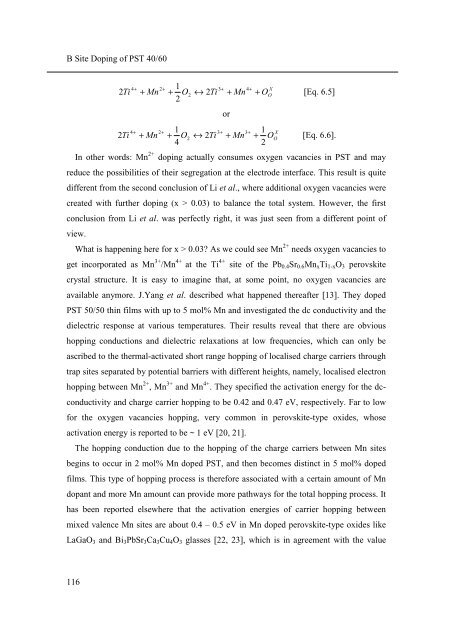PhD Thesis Arne Lüker final version V4 - Cranfield University
PhD Thesis Arne Lüker final version V4 - Cranfield University
PhD Thesis Arne Lüker final version V4 - Cranfield University
You also want an ePaper? Increase the reach of your titles
YUMPU automatically turns print PDFs into web optimized ePapers that Google loves.
B Site Doping of PST 40/60<br />
116<br />
4+<br />
2+<br />
1<br />
3+<br />
4+<br />
X<br />
2 Ti + Mn + O2<br />
↔ 2Ti<br />
+ Mn + OO<br />
[Eq. 6.5]<br />
2<br />
2Ti<br />
4+<br />
+ Mn<br />
2+<br />
1<br />
+ O<br />
4<br />
2<br />
↔ 2Ti<br />
3+<br />
or<br />
+ Mn<br />
3+<br />
1<br />
+ O<br />
2<br />
X<br />
O<br />
[Eq. 6.6].<br />
In other words: Mn 2+ doping actually consumes oxygen vacancies in PST and may<br />
reduce the possibilities of their segregation at the electrode interface. This result is quite<br />
different from the second conclusion of Li et al., where additional oxygen vacancies were<br />
created with further doping (x > 0.03) to balance the total system. However, the first<br />
conclusion from Li et al. was perfectly right, it was just seen from a different point of<br />
view.<br />
What is happening here for x > 0.03? As we could see Mn 2+ needs oxygen vacancies to<br />
get incorporated as Mn 3+ /Mn 4+ at the Ti 4+ site of the Pb0.4Sr0.6MnxTi1-xO3 perovskite<br />
crystal structure. It is easy to imagine that, at some point, no oxygen vacancies are<br />
available anymore. J.Yang et al. described what happened thereafter [13]. They doped<br />
PST 50/50 thin films with up to 5 mol% Mn and investigated the dc conductivity and the<br />
dielectric response at various temperatures. Their results reveal that there are obvious<br />
hopping conductions and dielectric relaxations at low frequencies, which can only be<br />
ascribed to the thermal-activated short range hopping of localised charge carriers through<br />
trap sites separated by potential barriers with different heights, namely, localised electron<br />
hopping between Mn 2+ , Mn 3+ and Mn 4+ . They specified the activation energy for the dc-<br />
conductivity and charge carrier hopping to be 0.42 and 0.47 eV, respectively. Far to low<br />
for the oxygen vacancies hopping, very common in perovskite-type oxides, whose<br />
activation energy is reported to be ~ 1 eV [20, 21].<br />
The hopping conduction due to the hopping of the charge carriers between Mn sites<br />
begins to occur in 2 mol% Mn doped PST, and then becomes distinct in 5 mol% doped<br />
films. This type of hopping process is therefore associated with a certain amount of Mn<br />
dopant and more Mn amount can provide more pathways for the total hopping process. It<br />
has been reported elsewhere that the activation energies of carrier hopping between<br />
mixed valence Mn sites are about 0.4 – 0.5 eV in Mn doped perovskite-type oxides like<br />
LaGaO3 and Bi3PbSr3Ca3Cu4O3 glasses [22, 23], which is in agreement with the value

















